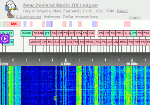AMERICA’S CROWDED ETHER
From the Evening Post, Volume CV, Issue 86, 12 April 1928, Page 7
America’s chief problem in connection with broadcasting is that their are too many broadcasters. They run into hundreds, and they cause serious interference. In connection with this difficulty it is frequently suggested that the shorter wave-lengths should be used. Those who, having a limited knowledge of the matter, bring this simple solution forward, overlooking a number of facts. One of these is that short waves are not suitable for transmission over short distances. Another “crash” is thus discussed in’ “Radio Broadcast”:
“A ‘New York Times’ headline proclaims that Dr. Lee Deforest has discovered room for 500,000 broadcasting stations. It is most irritating to read such misleading statements, because they afford an excuse for not dealing with broadcasting conditions as they exist in the present. The remedies of to-morrow do not alleviate the problem of to-day. Scrutiny of Dr. DeForest’s remarks shows that the usually accurate ‘Times’ misinterpreted what he said. He merely stated that there are some 6000 channels, with 10-kc. separation, between 200 and 10 meters (1500 and 30,000kc.) and that perhaps 500,000 radio telegraph stations could be disposed upon these frequencies if the double heterodyne method of transmission, requiring the use of low-frequency super-audible, master oscillators, were employed.
“Dr. Deforest also suggests that the same system might be utilised in the broadcasting band. Such a course would necessitate the complete scrapping of all transmitting and receiving equipment, and add a delicate manipulation somewhat beyond the skill of the average listener, to the tuning process. The remedy would cost a billion dollars— or what you will—and would not even accommodate all our present stations.
“Between 10 and 200 meters—considered a radio Utopia by experts in publicity and politics, there are 27,500,000 cycles, or 27,500 kilocycles, of frequency space. At 10-kc. separation, which is necessary for ordinary radio telephony, there are 2750 broadcasting channels for distribution among all the nations of the world. Some twenty of these are already used by stations broadcasting on this band as well as their regular longer-wave channels, some of which boast that they are broadcasting to the civilised world through their short-wave stations.
“This is a misconception because the only persons who listen to broadcasting on the short waves now are DX cranks. No civilised person would seek musical entertainment on these short waves because of the existing audio-frequency distortion for which no one has found a cure. Programmes are quite distinguishable at enormous distances, but they appeal to musical tastes about as much as a five-legged calf appeals to a stock breeder. To suggest relief broadcasting congestion by pointing to the numerous high frequencies is as practical as offering the vast Arctic spaces to the overcrowded populations of India.”



